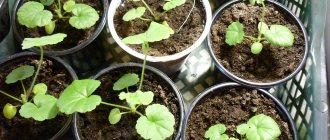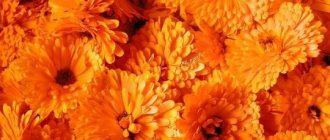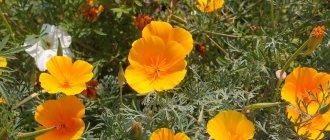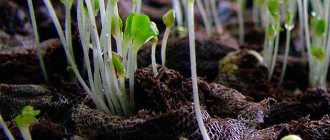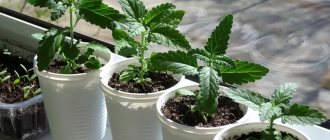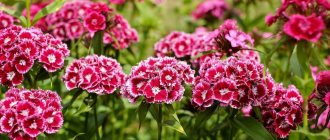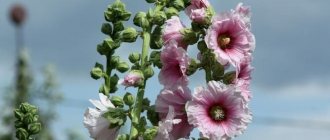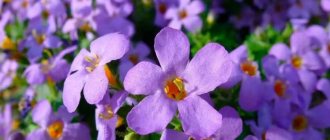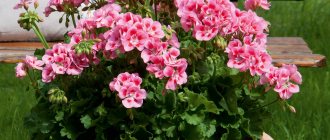Author: Elena N. https://floristics.info/ru/index.php?option=com_contact&view=contact&id=19 Category: Garden plants Published: January 05, 2019Last edits: January 13, 2021
- Rules of care
- Alpine Aquilegia (Aquilegia alpina)
This biennial is popularly called eagle or columbine; the ancient Germans believed that the flowers of this plant looked like elf slippers, and the British preferred to call aquilegia columbine (dove). This plant is widely in demand in landscape design: low-growing varieties are planted in rock gardens and in winter for forcing, and taller varieties are arranged in groups in ridges and mixborders. But most often aquilegia is used for winter bouquets.
Our article contains information about which types and varieties of aquilegia are the most popular, as well as:
- how to grow aquilegia from seeds;
- what other ways can this plant be propagated;
- how to care for aquilegia.
Popular types and varieties of aquilegia
More than a hundred varieties of aquilegia have been bred, but only a few of them are grown decoratively. The following types are especially popular:
Alpine . With proper care of the plant, the stems of this type of aquilegia grow up to 30-80 cm in height. The flowers of this variety grow quite large, up to 5-8 cm in diameter. There are spurs on the flowers - they are slightly curved and not very long. The color palette of this species includes various shades of blue.
Alpine
Ordinary . It belongs to the European species, reaches a height of 40-80 cm. The flowers grow about 5 cm in diameter. Varieties of this species come in various shades, but blue and purple are the most common. Flowers come with and without spurs, simple and double. This species is resistant to severe frosts.
Fan-shaped . There is another name for this species - Aquilegia Akita. The stems of the plant grow up to 60 cm in height, and the flowers are large – more than 5 cm in diameter. The flowers have spurs - they are quite long and slightly curved. Up to 5 large flowers can grow on one peduncle. The main shades of the variety are blue, pinkish, lilac-violet. The flowers have a fuzzy white border around the edges. This type of aquilegia reproduces very well by self-sowing.
Hybrid . The flowers are quite large - they grow about 9 cm in diameter, they come in various shapes and shades, there are varieties with and without spurs, the flowers are both double and ordinary. The height of the plant stems can reach 1 m.
Canadian . The flowers of this species are red-yellow in color, with long spurs. This type of aquilegia grows well in the shade and loves moist soil.
Dark . The flowers are small - up to 4 cm in diameter, drooping, dark shades predominate. The spurs are small, but very beautifully curved. Flowering of this species begins in early summer. Grows well in both partial shade and shade. With insufficient watering, it can quickly wither in sunny areas.
Skinner's Aquilegia .
The flowers are drooping, red-yellow in color, the spurs are long and straight. This type of aquilegia is not afraid of frost. Tolerates even the coldest winters well. Aquilegia goldenflower . The flowers are large, with a golden tint and long spurs. Tolerates cold and dry weather well.
Aquilegia olympic . Height is 30-60 cm, the stems are covered with thick fluff. The flowers are light blue, quite large – about 10 cm in diameter. There are long spurs. Flowering period is May-June.
In addition to these species, there are other varieties of aquilegia, for example, ferruginous, blue, small-flowered and bicolor, Siberian and others.
The most popular varieties of Aquilegia:
- Barlow Rose. Plant height is up to 80 cm. The flowers are large, pale pink in color, with a terry border.
- Winky. This variety is often used for garden and indoor floriculture. The height of the plants is no more than 35 cm. The flowers are red, purple, pink, directed straight upward. Blooms in May-June.
- Blue Star. Large flowers, up to 10 cm in diameter. The color is dark blue with a white core. Height is about 80 cm.
When to sow aquilegia for seedlings
Aquilegia can be grown for seedlings in containers or in open ground, and sowing can be done both in spring and autumn.
Spring sowing in seedling boxes is usually carried out in March, but preparatory work (stratification, scarification) begins a month before - in late January-early February. And when 3–4 true leaves appear on the plants, they are transplanted into open ground.
When sowing in autumn in open ground, stratification is not required. Aquilegia seeds can be sown in a temporary bed. When the seedlings appear in the spring and grow a little, they are transplanted directly into the flowerbed.
Botanical features of the plant
The flower belongs to the perennial crops. The history of its origin goes back centuries, has a Latin name consisting of 2 parts:
- water;
- gather.
Flowering, regardless of the planting method, occurs in the second year. You can plant in open ground:
- seedlings;
- seeds (not recommended);
- dividing the bush.
The color of the petals is varied. Varies from white to lilac. Low-growing and tall-growing varieties. Some varietal species have double petals.
The height of the orlik, depending on the variety, can exceed 100 cm. The inflorescences are from 3 to 8 cm in diameter.
A distinctive feature of aquilegia from most flower crops is its ease of care. And development and growth in the shade, love of moisture. Also, the “elf’s slipper” is a cold-resistant flower, which attracts gardeners in the northern regions.
There is one downside: flowering lasts a maximum of 1 month.
Growing aquilegia from seeds step by step
Before sowing seeds for seedlings, preparatory work is first carried out, and then the sowing itself is carried out.
Preparing the soil and container
Aquilegia loves light soil that does not accumulate moisture and is moderately nutritious.
To grow aquilegia from seeds, you can use a universal mixture that is sold in specialized stores, or you can prepare it yourself.
You can use the following mixture options:
- turf soil, leaf soil, humus, river sand;
- turf soil, humus, sand.
All components are taken in equal parts.
It is better to grow seedlings in tall boxes or containers so that the long roots of the plant can go deeper. But at first, seeds for seedlings can be planted in small containers (for example, plastic containers with lids). And in the future it will be possible to transplant the seedlings into separate and deeper containers (pots or cups), in which drainage holes will need to be made.
About a day before planting the seeds, the substrate is poured into the container and lightly compacted. The soil is watered and excess liquid is allowed to drain out.
Before sowing the seeds, the soil must be sifted well to make it looser. This will help the seeds to hatch quickly and easily. It is also necessary to disinfect the soil by spilling it with a fungicide or adding phytosporin to the substrate.
Seed preparation
Aquilegia seeds are active only for one year, then their vital energy weakens significantly. To provide yourself with good seed material, you can use the following tips:
- seeds are sown immediately after they are collected;
- the collected seeds are stored in a cool, dark place;
- a month before planting, stratification or scarification is carried out;
- treat the seeds with a solution of growth stimulants.
As mentioned above, when sowing in spring, the seeds must be hardened. With the help of hardening, you can achieve more active and friendly shoots. The seed material is kept in the refrigerator (i.e. subjected to stratification) for 1-1.5 months, at a temperature of 0 +5°C. Seeds are placed in damp sand or on moistened cotton pads.
You can also carry out scarification (exposing the seeds to heat) - the seed is kept for about 30 days at a temperature of +34-36 °C.
Important! Stratification or scarification improves seed germination. But this does not mean that without these agricultural techniques nothing will germinate, especially if you do not doubt the quality of your seeds.
Sowing
Sowing aquilegia seeds for seedlings step by step:
- The container or box is filled with a nutrient mixture.
- The soil is well moistened with a spray bottle.
- The seeds are evenly distributed over the entire surface of the soil and sprinkled with 0.5 cm of soil.
- The plantings are moistened with a spray bottle.
- The container is covered with a lid (if a container is used) or covered with film to create a greenhouse effect.
- Containers with plantings are placed in a warm place. Aquilegia seeds germinate well at air temperatures of + 18-22 °C.
When the first shoots hatch (about 10-14 days), the cover is removed.
Advice! Since aquilegia seeds are very small, it is convenient to plant them using a toothpick, which must first be moistened with water.
Sowing aquilegia in the snow - video
Propagation by seeds
Aquilegia seeds have good germination, so its propagation is mainly carried out in this way. Sowing can be done both in seedling boxes and in open ground.
When choosing a container for seedlings, it is recommended to choose boxes or pots that are deep enough to give the plant plenty of room for root development. For diving, you should choose peat or paper cups. They allow you to immediately plant the crop in open soil.
For aquilegia, a universal seedling substrate or any light soil is suitable. You can create a soil mixture yourself - mix turf soil, humus and sand.
Features of sowing
As for the timing of sowing seeds in a container or in the ground, the best time is autumn. An alternative is early spring, but then the seeds must first be stratified. This process involves creating conditions for the seeds that imitate natural ones - a humid environment with a low positive temperature.
On a note! When sowing freshly harvested seeds, preplanting treatment is not necessary.
If sowing is carried out in the fall, then this procedure comes down to the following steps:
- Seeds are evenly distributed over a bed of dug up loose soil.
- They are sprinkled on top with a thin layer of soil - about 5 mm.
- Watering is carried out.
- Mulch the beds with humus and cover them with dry leaves.
In spring, sowing in open ground is carried out in April or May. Before this, they must be stratified. Then the seed material is stored in the cold. There are several types of stratification:
- Place the seeds in the refrigerator for 4-6 weeks.
- Mix the grains with soil and put them in the refrigerator for the whole winter.
- Place the seeds or their mixture with sand in a snowdrift.
- Keep the seeds at 35°C for 4 weeks.
- Sand the seedlings with sandpaper.
- Mix the grains with calcined river sand and moisten it with a spray bottle. Put the bag on and put it in the refrigerator for 4-5 weeks.
Sowing seeds in spring for seedlings is accompanied by the following actions:
- The containers are filled with soil and watered with warm water.
- Sow aquilegia seeds over the surface, but not too densely. Sprinkle them with a thin layer of soil on top and cover them with film or glass.
- Containers must be kept indoors.
In open ground, seeds are sown to a depth of 5 mm, after which the soil is covered with film. In order for seedlings to appear as quickly as possible, you need to constantly water them. The shelter is removed after most of the seeds have sprouted.
Aquilegia seedlings
The most difficult thing to germinate is old seeds that are more than 2 years old. Then the procedure for sowing in containers changes somewhat. Stratification is carried out after the seeds have entered the soil:
- The seedlings are washed in water and soaked in a warm manganese solution.
- Sow into a leveled substrate and sprinkle the seeds with soil.
- Leave the containers in this form for 3-4 days at room temperature.
- The pots are taken outside or into the refrigerator for stratification for 5-6 weeks.
- After this, the containers are left at room conditions.
Both cold and heat are equally harmful to plant seeds. The suitable temperature for germination is 15-18°C. The light should be diffused and moderately bright.
The seedlings are grown in containers until the second leaf appears. The seedlings are protected from drought and waterlogging. Watering is carried out carefully and in doses.
Picking
It is recommended to plant sprouts in prepared beds. If the seeds are sown early, and it is not possible to plant them in a greenhouse, then the plants are planted in individual pots or large boxes, increasing the distance between flowers, and planted in the ground already in June.
Picking seedlings into large containers
Picking aquilegia should be done carefully, trying to avoid injury to the roots. The seedlings should be in the same cool microclimate. Additional lighting for 1-2 hours will only benefit the plants.
Aquilegia seedlings in open ground are thinned out, leaving a gap of 5-20 cm between plants.
Flowering of aquilegia planted in spring should be expected only in the second year.
Seedling care
Growing aquilegia seedlings need sufficiently long daylight hours and moderate watering. Water moderately so as not to provoke the appearance of a “black leg”.
Aquilegia develops a root system quite quickly, and it also has a very long taproot, so if the seeds were sown in a shallow container, then when the seedlings have 2-3 true leaves (about 30 days after planting), it will need to be transplanted into deeper containers (with drainage holes).
Do the dive in the morning or evening. Immediately after transplanting, the plants are well watered. In the future, watering should also be moderate as the top layer of soil dries. Every 10-14 days, seedlings are fed with complex fertilizers.
When to plant aquilegia in open ground
When the threat of return frosts has passed, the plants are transplanted into open ground. This happens about a month after picking (or two months after planting the seeds); by that time the seedlings will have grown well and become strong. It is better not to rush with the transplant and wait until the air warms up to at least +15°C.
Important! The plant can withstand temperature drops of no more than +5 degrees.
Aquilegia is a fairly unpretentious plant; it can be planted both in the sun and in partial shade, and even in the deep shade of garden trees or bushes, since it is shade-tolerant.
Planting aquilegia seedlings in a permanent place occurs as follows:
- Choose the most suitable place on the site in partial shade or shade;
- Prepare holes according to the size of the container in which the seedlings grew;
- Water the planting container in advance so that you can easily remove the seedlings from it.
- Carefully remove the plants, place them in the holes, sprinkle them with soil and press them down.
- Seedlings are planted at a distance of at least 30-35 cm from each other.
- Planted plants are well watered.
- The space between the plants and the ground around the stems are well mulched. You can use hardwood sawdust, hay, straw or dry peat as mulch. Mulch will help retain moisture and prevent increased weed germination.
In the first year, for aquilegia, choose a place protected from the wind and protected from direct sunlight, since young plants can simply burn under the scorching sun.
The land for planting is prepared in two to three weeks:
- dig up;
- make deep holes (about 25 cm) so that the seedlings fit together with the earthen ball;
- if necessary, lay out a drainage layer;
- a small amount of humus or compost is placed at the bottom of the holes;
The seedlings are placed in prepared holes, covered with soil and well moistened.
Propagation by cuttings.
Aquilegia is a cross-pollinated plant , and if there are several species or varieties blooming at the same time on your site, it is quite difficult to obtain pure-quality seeds. In order for new plants to retain all their parental characteristics, it is better to propagate aquilegia by cuttings .
At the base of the stems of adult plants, basal rosettes are formed, which are successfully used for propagation. In the spring, when the leaves have not yet blossomed and are pinkish in color, carefully break out or cut off the young rosettes at the very root collar. Treat them with a growth stimulator - you can soak them in a heteroauxin or dust the lower cut with powder.
It is best to root cuttings in a greenhouse, greenhouse or special bed. First, pour a thick layer of coarse sand, followed by a layer of fertile, loose soil. Place disinfected sand on top in a layer of 0.5–1 cm.
Plant the cuttings to a depth of no more than 1 cm , placing them so that the heel is in the sand and does not touch the ground underneath. Cover the plantings with film, glass or covering material, under which a constant temperature and humidity will be maintained.
During rooting, protect the cuttings from direct sunlight, regularly spray and ventilate, lifting the film for a short time. Keep the soil moderately moist.
For propagation, you can use cuttings that appear on mother plants at the end of summer. But they take root much worse than spring ones, so for the winter the plantings must be carefully covered with spruce branches .
How to properly care for aquilegia in summer
In the first year after planting, aquilegia does not bloom; all the plant’s efforts are aimed at adapting to a new place and growing a powerful root system.
But already in the second year after planting - at the end of May-beginning of June, you can enjoy the first flowers. Aquilegia blooms in full force only in the third year after planting.
Caring for a planted plant comes down to the following procedures:
- Timely removal of weeds and loosening of the soil.
- Fertilizer application.
- Moderate soil moisture. The plant has a rather long central root, so it rarely suffers from lack of moisture.
- Tying up tall species. The plants are tied to wooden stakes using twine.
As the roots of aquilegia grow, they often begin to protrude from the ground; they are sprinkled with rotted peat or just a new ball of soil. This procedure is carried out in spring and summer.
For lush flowering (2-3 weeks after planting), mineral fertilizers are applied:
- superphosphate – 50-60 grams per 1 sq. m;
- potassium salt – 15-20 grams per 1 sq. m;
- saltpeter - 20-30 grams per 1 sq. m.
In summer, aquilegia is watered with organic fertilizers. Use diluted manure and urea. You can also use ready-made complex fertilizers. This will help the plant gain more green mass.
Grown plants that are already 2-3 years old are fed twice a season. In spring, nitrogen fertilizers are used, and when buds appear, potassium fertilizers are used.
Aquilegia is one of those plants in which it is necessary to remove dry (which have already bloomed) flower stalks so that the plant does not waste its energy on setting seeds.
Methods for propagating aquilegia
Aquilegia can be propagated not only by seeds, but also by cuttings and dividing the bush.
Cuttings are considered the simplest method of plant propagation. Cuttings are harvested in the spring, long before the leaves begin to bloom. First, young and large shoots with internodes are cut off.
The cut is treated with a growth stimulator. Shoots are planted directly in open ground, but you can start by planting them in any container. Next, the cutting is covered with plastic wrap or a plastic bottle.
For the first 10 days, the shelter in the plants is not removed at all, and then it is periodically ventilated (no more than half an hour a day) and moistened the soil. The cuttings are planted in loose soil with good drainage. When planting, add coarse granulated sand. When the cuttings adapt and take new roots, they are transplanted to a permanent place of growth.
The method of dividing a bush is not used very often. It is used, as a rule, if there is a need to preserve a plant variety. The roots of aquilegia grow quite deep into the ground, the plant is fragile and does not tolerate the procedure of division and replanting. The bush is divided in early spring, or in early September. For division, use bushes that are more than 3 years old.
The procedure for dividing aquilegia is carried out as follows:
- The bushes of the plant are dug up, the roots are well cleaned of adhering soil.
- All stems are trimmed and leaves are completely removed.
- The root is divided into two even parts. Both divisions must have healthy buds and strong roots.
- The place where the cut was made is well treated with crushed coal, and the cuttings are carefully planted in previously prepared soil.
- The soil is pressed well and watered.
How and when to collect your seeds
Aquilegia seeds are sold everywhere, and you can buy them at any flower shop, or you can collect them yourself from plants already growing on the site. If this plant is already growing in your garden or flower bed, then the seeds for its propagation can be collected very simply. They are also stored well, and do not lose their quality throughout the whole year.
Aquilegia seeds begin to ripen in early August and are harvested immediately after small green pods appear on the stems. If they are not collected in time, they begin to crumble to the ground. It is necessary to dry the seeds at room temperature, placing them on a saucer or on a napkin.
But you can also not collect the seeds, but leave them on the bushes, then you can reproduce by self-sowing.
What problems to watch out for when growing aquilegia
We have great news for you: columbine is a plant that has excellent immunity. Pests practically do not touch these flowers, and diseases, as a rule, bypass them. However, if high humidity remains outside for a long period and precipitation does not stop, powdery mildew may attack the aquilegia. If something like this happens to your variegated flower garden, buy the drug “Pure Flower” or “Skor” and treat the plants with it according to the instructions.
Before using the drugs, you can try the folk method of combating powdery mildew: dilute a large spoon of soda in a five-liter jar of water and treat the bushes and soil by spraying.
Pruning the plant after flowering, preparing for winter
When the plant has finished blooming, remove all flower stems, as they have already lost their decorative beauty. They also inspect the entire bush at the same time - remove dry and damaged leaves. You can also cut off the entire above-ground part of the bush, because with the arrival of spring new stems will grow.
It is also very important to check the base of the flowers; in mature plants (over 3 years old), roots begin to emerge from the soil. To prevent the plant from freezing in winter, all roots protruding from the ground are covered with compost, pre-mixed in equal proportions with manure. Such a shelter will protect the roots well from severe frosts and serve as additional fertilizer.
With such a variety of aquilegia varieties, every gardener will be able to choose a variety that will decorate his plot with delightful flowers. You can choose several types of this plant and create a fabulous composition that will decorate your garden or local area.
Diseases and pests
| Diseases/Pests | Symptoms | Corrective measures |
| Powdery mildew | White, rusty or brown coating on the leaves, darkening and death of the ground parts. | Infected parts are removed and sprayed with a solution of laundry soap and copper sulfate or with sulfur-containing antifungal drugs. |
| Rust | ||
| Gray rot | ||
| Aphid | Small green insects, sticky coating. | Undamaged bushes are treated with Actellik, Karbofos, and yarrow paste. Application and precautions according to instructions. |
| Spider mite | Cobwebs, insects on leaves. |
Aquilegia in landscape design - photo
Aquilegia yellow
